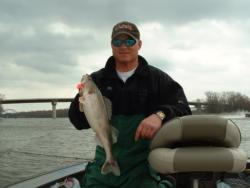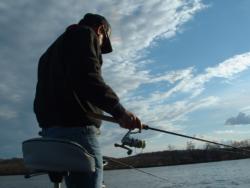Mud bowl
In turbid climes, sauger are scarce ahead of RCL Tour event on Illinois River

SPRING VALLEY, Ill. – Here, on one of the world’s foremost sauger fisheries, the weather, the water level and, therefore, the results during pre-tournament practice have been nothing if not erratic. Following heavy rains upstream around Chicago, any consistency in the action before last weekend has faltered with high, muddy water approaching flood stage.
Now, with competition to start Wednesday, a cold front with temperatures falling to 30 degrees, rain and possible snow is forecast to make matters worse on a turbid river currently laced with enough mud to drop visibility to less than 6 inches and enough debris to foul fishing lures continuously.
“If it wasn’t going to snow, I’d say we’d have a phenomenal bite later in the tournament after the weather stables out,” says RCL pro John Kolinski of Greenville, Wis., winner of last year’s Illinois River event. “You have to remember, the biggest thing walleye and sauger don’t like is change. It shuts them down. This is change.”
And times have changed even more drastically since a year ago, when water levels were the lowest in recent memory, a trolling bite was roistering and more than 22 pounds was needed to make the top-20 cut. If conditions are any indication of the upcoming difficulty, more than 100 zeroes could be tallied on the first day of competition.
 “From last year to this year, the big difference is not so much that the river is high, it’s that it keeps climbing,” says Jeff Manz of Vanderbilt, Mich., a top-20 finisher in last year’s tourney. “Not only is it higher every day, there’s more junk floating in the river. I can’t do anything I did here last year.”
“From last year to this year, the big difference is not so much that the river is high, it’s that it keeps climbing,” says Jeff Manz of Vanderbilt, Mich., a top-20 finisher in last year’s tourney. “Not only is it higher every day, there’s more junk floating in the river. I can’t do anything I did here last year.”
Furthermore, what few patterns have been established during practice are bound to change even more with a river level that, according to the U.S. Army Corps of Engineers, has not yet crested and could soon surpass the banks. The Illinois is expected to reach its high point late Tuesday night before it starts falling and, in time, clearing. It’s entirely plausible that the best weights will come in the finals after the scant poundage it will likely take to make the cut.
“Even if you’ve been lucky enough to get a few fish, by Wednesday it’s going to be a totally different picture,” says Lund pro Mark Martin of Twin Lake, Mich. “The rising water is going to be reorienting the fish and moving them around from where you’ve found them.”
Considering the conditions, the best hope will be to stake out known fish-holding areas where the current is somewhat less than raging and to approach them with jigging techniques or trolling tactics that put the bait in the fishes’ faces.
In your face, sauger
 For Kolinski, a talented jigger with considerable experience on the Illinois, a few tricks might help inspire the few bites that could make a major difference. When faced with high, dirty water, Kolinski first looks for areas where the current is deflected and reduced. He then plans to employ vertical jigs, his winning technique from last year, with hair jigs made of marabou that give the appearance of greater size and profile for added visibility when there is none. Kolinski said he might alternately test Berkley Power Baits for the extra size and scent. To the jigs he adds a stinger hook – a treble tweaked into the tail of a minnow – to target the fish that strike short.
For Kolinski, a talented jigger with considerable experience on the Illinois, a few tricks might help inspire the few bites that could make a major difference. When faced with high, dirty water, Kolinski first looks for areas where the current is deflected and reduced. He then plans to employ vertical jigs, his winning technique from last year, with hair jigs made of marabou that give the appearance of greater size and profile for added visibility when there is none. Kolinski said he might alternately test Berkley Power Baits for the extra size and scent. To the jigs he adds a stinger hook – a treble tweaked into the tail of a minnow – to target the fish that strike short.
Another tack is to troll with handlines, a technique that puts a weight in excess of a pound on the bottom in current. With it, the trollers without rods creep upstream with a gas kicker motor and pull twin minnowbaits on leaders that keep the lures in the fish zone within inches of bottom. This provides maximum bait exposure to fish hanging out behind rocks or along ledges to dodge the current.
Which is just where venerable handliner and Ranger pro Rick LaCourse of Port Clinton, Ohio, expects to find them in spite of the treacherous conditions.
“This is going to play into my game,” LaCourse says. “Catching a limit of small fish might be more and more the key. If the water gets higher and higher, I might know where to go.”
Unlike jigs, the crankbaits trolled on handlines throw off vibration and, depending on the choice, creates a rattle sound necessary to call attention to the baits in dirty water. The downside of lures with twin or triple trebles, though, is the amount of leaves, weeds and other debris they pick up when the river is high and roiling with garbage.
“Even though it may be best to run cranks,” Martin says, “they may not be the most efficient presentation to keep clean.”
More change
In keeping with standard Wal-Mart RCL Walleye Tour operating procedures, there are no boundaries for the circuit’s second visit to Spring Valley, and anglers have about 60 miles of river between the dams at Starved Rock and Peoria, Ill., plus the possibility of locking through to pools on either side. The size limit for sauger for the tournament is the state minimum of 14 inches.
A change in format, however, is in the offing. New for 2004 in the RCL is a top-20 cut followed to a top-10 cut for finals – determined by cumulative weight over days three and four.
The action, however little or much of it ultimately occurs with the muddy waters, starts with the 7 a.m. Central launch Wednesday at the Spring Valley Boat Club.